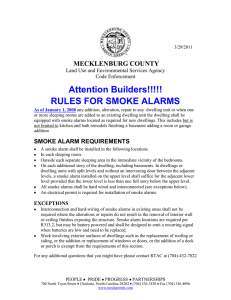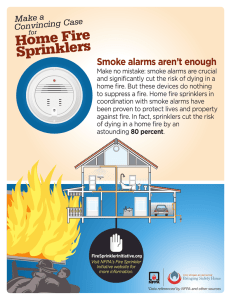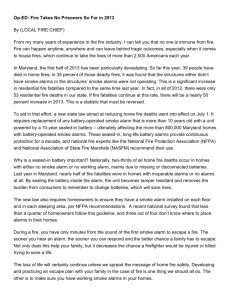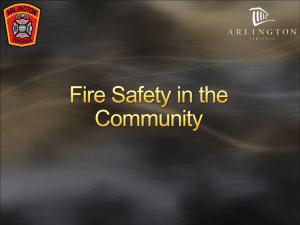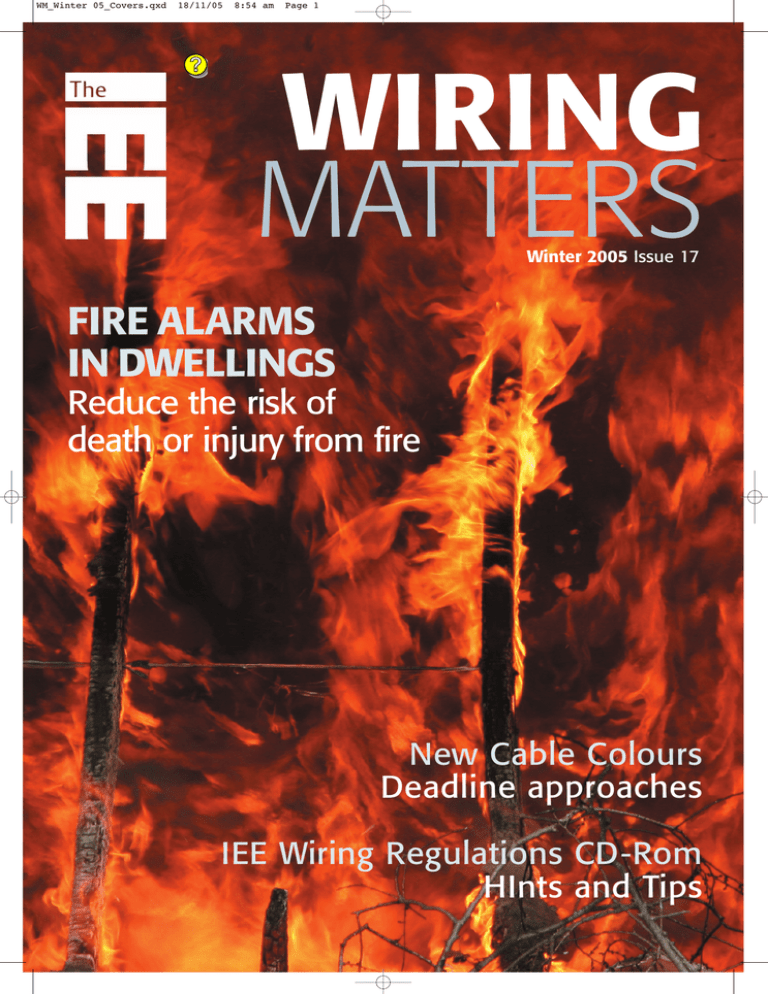
WM_Winter 05_Covers.qxd
18/11/05
?
8:54 am
Page 1
WIRING
MATTERS
Winter 2005 Issue 17
FIRE ALARMS
IN DWELLINGS
Reduce the risk of
death or injury from fire
New Cable Colours
Deadline approaches
IEE Wiring Regulations CD-Rom
HInts and Tips
17/11/05
6:55 am
Page 1
FIRE ALARMS
WM_Winter 05_part1_EW.qxd
1
FIRE ALARMS
IN DWELLINGS
IN THE UK around 80% of
all fire deaths and
injuries occur in dwellings, a total of 450 to 500
deaths and 14,000 injuries per annum, according to
BS 5839-6: 2004.
The installation of a fire detection and alarm
system can significantly reduce the risk of death or
serious injury from fire. The fatality rate in fires in
dwellings is three times higher where there is no
smoke detector or where it is not working compared
to dwellings where a fully functioning smoke detector
is fitted. The installation of automatic smoke
detectors is, effectively, required in new dwellings to
satisfy Building Regulations.
BUILDING REGULATIONS
Approved Document B of the Building Regulations
(2000), Fire Safety, deals with the following
Requirement from Part B of schedule 1 to the
Building Regulations 2000.
Means of warning and escape
B1. The building shall be designed and constructed
so that there are appropriate provisions for the early
warning of fire, and appropriate means of escape in
case of fire from the building to a place of safety
outside the building capable of being safely and
effectively used at all material times.
Approved Document B states, in paragraph 1.2 that
in most houses the installation of smoke alarms or
automatic fire detection and alarm systems, can
significantly increase the level of safety by
automatically giving an early warning of fire. The
document also states, in paragraph 1.3, that if houses
are not protected by an automatic fire detection and
alarm system in accordance with the relevant
recommendations of BS 5839: Part 1 Fire detection and
alarm systems for buildings, Code of practice for
By John Ware
system design, installation and servicing to at least an
L3 standard, or BS 5839: Part 6 Code of practice for the
design and installation of fire detection and alarm
systems in dwellings to at least a Grade E type LD3
standard, they should be provided with a suitable
number of smoke alarms installed in accordance with
the guidance in paragraphs 1.4 to 1.22 of the Approved
Document.
Approved Document B can be downloaded free of
charge from the Building Regulations section of the
website of the Office of the Deputy Prime Minister at
www.odpm.gov.uk
BS 5839-6: 2004
Electrical designers and contractors with
responsibilities for design, installation or
maintenance of fire alarm systems in dwellings
should be aware of the recommendations given in BS
5839-6: 2004 Fire detection and fire alarm systems for
buildings – Part 6: Code of practice for the design,
installation, and maintenance of fire detection and
fire alarm systems in dwellings and should obtain a
copy of BS 5839-6 from BSI at 389 Chiswick High Road,
London W4 4AL Tel: 0208 996 9000, www.bsiglobal.com. The recommendations given in BS 5839-6
applicable to houses, bungalows and flats are
discussed in this article.
Grades of system
The Grades of system for fire alarm systems in
dwellings range from Grade A to Grade F. Grade A
and B systems are systems of a type described in
BS 5839-1. In a Grade C system, the fire detectors are
supplied with a common power supply unit with
central control equipment and this type of system
normally incorporates a secondary rechargeable
battery. Fire alarm systems in dwellings are, in
most cases, Grade D, E or F which do not employ
a control panel.
IEE Wiring Matters | Winter 2005 | www.iee.org
17/11/05
6:55 am
Page 2
FIRE ALARMS
WM_Winter 05_part1_EW.qxd
2
Grade Description and explanation
D
A system of one or more mains-powered
smoke alarms, each with an integral standby
supply. The system may, in addition, incorporate
one or more mains-powered heat alarms, each
with an integral standby supply.
One or more batteries or capacitors is provided
to ensure protection is available under loss of
mains conditions.
E
A system of one or more mains-powered smoke
alarms with no standby supply. The system may,
in addition, incorporate one or more heat
alarms, with or without standby supplies.
The system is potentially more reliable than a
Grade F system, because it requires less
attention by the user. The cost of the system
is higher as a mains supply and interlinking
cables are required and the detectors
themselves cost slightly more.
Categories of system
Fire alarm systems are usually installed in dwellings to protect
life (L) but may also be installed to protect property (P). Fire
alarm systems are divided into the following categories:
Grade
Description and explanation
LD
LD1
A system installed throughout the dwelling
incorporating detectors in all circulation
spaces that form part of the escape routes
from the dwelling, and in all rooms and
areas in which fire might start, other than
toilets, bathrooms and shower rooms
LD2
A system incorporating detectors in all
circulation spaces that form part of the
escape routes from the dwelling, and in
all rooms or areas that present a high fire
risk to occupants
LD3
A system incorporating detectors in all
circulation spaces that form part of the
escape routes from the dwelling
PD1
A system installed throughout the dwelling
incorporating detectors in all areas in which
fire might start other than toilets, bath and
shower rooms
PD2
A system incorporating detectors only in
defined rooms or areas of the dwelling in
which the risk of fire to property is judged
to warrant their provision
Objective
of category
L systems is
the protection
of life
(D means
dwelling)
Loss of mains results in loss of protection.
F
A system of one or more battery-powered
smoke alarms. The system may, in addition,
incorporate one or more battery-powered
heat alarms.
Grade F systems are the simplest form of fire
detection and alarm system, are low cost and
relatively simple to install. Smoke alarms to
BS 5446-1 and heat alarms to BS 5446-2 give
a low battery warning.
A disadvantage of a Grade F system is that
removal of the battery disables the protection.
PD
Published by IEE Publishing & Information Services Michael Faraday House, Six Hills Way, Stevenage, Herts, SG1 2AY, United Kingdom
Tel: +44 (0)1438 313311 Fax: +44 (0)1438 313465
Sales and Project Coordinator L Hall +44 (0)1438 767351 lhall@iee.org.uk | Editor G D Cronshaw +44 (0)1438 767384
gcronshaw@iee.org.uk | Contributing Editors J Ware, M Coles, I Reeve | Chief Sub Editor Jim Hannah | Design SaBle Media Solutions
IEE Wiring Matters is a quarterly publication from the Institution of Electrical Engineers (IEE). The IEE is not as a body responsible for the
opinions expressed.
©2005: The Institution of Electrical Engineers. All rights reserved. No part of this publication may be reproduced, stored in a retrieval system,
or transmitted in any form or by any means without the permission in writing of the publisher. Copying of articles is not permitted except for
personal and internal use. Multiple copying of the content of this publication without permission is always illegal. Web-offset printing by
Wyndeham Heron, The Bentall Complex, Colchester Road, Heybridge, Maldon, Essex, UK
Co-operating Organisations The Institution of Electrical Engineers acknowledges the contribution made by the following
organisations in the preparation of this publication: British Electrotechnical & Allied Manufacturers Association Ltd – R Lewington,
P D Galbraith, M H Mullins, P Sayer | Office of the Deputy Prime Minister – K Bromley, I Drummond | Electrical Contractors Association –
D Locke, S Burchell | City & Guilds of London Institute – H R Lovegrove | Energy Networks Association –D J Start | Electrical Contractors
Association of Scotland SELECT – D Millar, N McGuiness | Health & Safety Executive – N Gove | National Inspection Council for Electrical
Installation Contracting | ERA Technology Limited – M Coates | British Cables Association – C Reed
IEE Wiring Matters | Winter 2005 | www.iee.org
17/11/05
6:56 am
Page 4
FIRE ALARMS
WM_Winter 05_part1_EW.qxd
4
The Category of system needs to be defined in the specification and, except for
Category LD1 or PD1 systems, the details of the areas of the building to be
protected. Statutory requirements imposed by enforcing authorities and any
requirements imposed by property insurers should state the Category of
system required.
The minimum Grade and Category of fire detection and alarm system for
protection of life in typical dwellings is given in the Table below (Part of Table
1 of BS 5839-6. Refer to BS 5839 for full details)
Installation of fire alarm systems
Power supplies
Smoke and heat alarms that are to be
System Power supply
recommendations
Grade D
The mains supply to smoke and
heat alarms should either be a
single independent circuit from the
dwelling’s main distribution board
or a separately electricallyprotected regularly used local
lighting circuit.
Grade E
The mains supply to smoke and
heat alarms should be a single
dedicated independent circuit from
the dwelling’s main distribution
board.
Minimum Grade and Category
of system to be installed
Class of
dwelling
New or materially
altered dwelling
complying with the
recommendations of
BS 5588-1 (a)
New or materially
altered dwelling
complying with the
recommendations of
BS 5588-1 (a)
Existing dwelling
where the structural
fire precautions are of
a lower standard
than the
recommendations of
BS 5588-1 (a)
Smoke and heat alarms should be
interconnected and, in this case,
must be supplied from the same
circuit.
Single family dwelling with no floor area greater than 200 m2 in area
Bungalow, flat, Grade
or owneroccupied
maisonette or
2-storey house D
Category
Grade
Category
Grade
Category
LD2
F(b)
LD3
D
LD2
Rented
maisonette or
D
2-storey
house
LD2
D
LD3
D
LD2
3-storey
house
D
LD2
D
LD3
D
LD2
4 or more
storey house
B
LD2
D
LD2
B
LD2
Single family dwelling with one or more floors greater than 200 m2 in area
Bungalow
or flat
D
LD2
D
LD3
D
LD2
Maisonette or
B
2-storey
house
LD2
B
LD2
B
LD2
Three
(or more)
storey house
Grade A Category LD2. Refer to BS 5839-6 for full details
(a)
Or guidance that supports national building regulations. For England and Wales see Approved Document B. BS 5588 is entitled
Fire precautions in the design, construction and use of buildings
(b)
A Grade E system should be fitted if there is any doubt as to whether the occupier will replace batteries.
But a Grade D system should be fitted if the electricity supply might be disconnected because the occupier cannot pay for the supply
Batteries in smoke alarms in rented bungalows or flats should have a life of at least 5 years (with normal use) and removal
should necessitate a tool.
IEE Wiring Matters | Winter 2005 | www.iee.org
The circuit supplying the smoke
and heat alarms should preferably
not be protected by an RCD unless
one is required for reasons of
electrical safety, then either the
RCD should serve only the circuit
supplying the smoke or heat
alarms or the RCD protection of the
fire alarm system should operate
independently of any RCD
protection for circuits supplying
socket-outlets or portable
equipment.
Grade F
The batteries of smoke alarms
and any heat alarms should be
capable of supplying the normal
load, including the additional
load from routine weekly testing
for at least one year before the
battery fault warning is given.
At the point at which the battery
fault warning commences, the
batteries should have sufficient
capacity to give a fire alarm
warning signal for at least 4
minutes or, in the absence of a
fire, a battery fault warning for at
least 30 days.
17/11/05
6:56 am
Page 6
FIRE ALARMS
WM_Winter 05_part1_EW.qxd
6
CIRCUITSTOLIGHTS
COOKERWATER
HEATERSMOKEALARMS
CIRCUITSTOPORTABLEEQUIPMENTOUTDOORS
ANDSOCKETOUTLETSTHATMAYREASONABLY
SUPPLYPORTABLEEQUIPMENTOUTDOORS
main switch
MAINSWITCH
(100 mA time
delayed RCD)
ISOLATOR
S-type, double pole
to BS EN 61008
M!
2#$
CONSUMERUNITWITHINSULATED
ENCLOSUREORADDITIONALPROTECTION
TOMETERANDISOLATORTAILS
interconnected by wiring should be connected on a single final
circuit. Note that certain alarms are radio linked and such alarms
need not be on the same final circuit
Wiring systems
All cables should be selected and installed in accordance with the
requirements of BS 7671 and the recommendations of BS 5839-6.
Additional recommendations include:
System Wiring system recommendations
Grade D Cables used for the mains supply to smoke alarms, any heat
alarms and any interconnecting wiring may comprise any
and
Grade E cable suitable for domestic mains wiring
Cables used for interconnecting smoke and heat alarms
should be readily distinguishable from those supplying
power, (for example by red colour coding). Such cables need
not be fire resistant.
Cables used for unmonitored circuits should be protected
against damage
Grade F
Cables suitable for the voltage or current is suitable.
Cables used for unmonitored circuits should be protected
against damage
IEE Wiring Matters | Winter 2005 | www.iee.org
Fig 1: Supply to a Grade E system where the
installation forms part of a TT system.
The 100 mA time-delayed RCD provides
protection for the fire alarm system (and other
circuits) and operates independently of the RCD
protection for the socket-outlets
Installation
Figs 2 to 4 (overleaf) illustrate the recommendations
given in BS 5839-6 for new houses, bungalows and flats
where each floor area is not greater than 200 m2. Heat
detectors should be installed in every kitchen and
principle habitable room. Alternatively, the detector in
the principle habitable room, but not the kitchen, may
be a smoke or carbon monoxide fire detector. Smoke
detectors should be installed in halls and landings.
The installation of the fire alarm system should
comply with the requirements of BS 7671. Additional
recommendations include:
Sounders should be rigidly fixed to permanent
construction. Wiring between detectors should be
installed and routed so that mechanical damage
is avoided.
The installer should provide as-fitted drawings.
Commissioning
The system should be inspected.
Electrical tests made to the mains supply circuit
should include earth continuity, polarity, and earth
fault loop impedance. Insulation tests should be made
of all installed cables as required by BS 7671.
Electronic equipment should be disconnected to
avoid damage.
17/11/05
7:23 am
Page 8
FIRE ALARMS
WM_Winter 05_part1_EW.qxd
8
Fig 2:
New two-storey dwelling
Fig 3:
New bungalow
The entire system should be tested to ensure that it
operates satisfactorily and that, in particular,
automatic fire detectors and any manual call points
function correctly when tested. Smoke detectors should
be smoke tested with a simulated smoke aerosol that
will not damage the detector. Heat detectors should be
tested by means of a suitable heat source unless
detector damage would otherwise result. The heat
source should not have the ability to cause a fire. A live
flame should not be used.
It should be established that any interlinking works
and that sounders operate correctly.
Manufacturer’s tests should be carried out.
Certification
A certificate should have been issued to the user and
this should be available for inspection. For Grade F
systems a certificate should be issued if installed by a
professional installer.
User instructions
The supplier of the fire alarm system should provide
the user with operating instructions, which should be
sufficient to enable a lay person to understand,
operate and maintain the system. Silencing and
disablement facilities should be explained but it
should be stressed that system readiness must not be
compromised. Recommended action in the event of a
fire must stress the importance of all occupants
leaving the building as quickly as possible and that
the fire service is summoned immediately regardless
of the size of the fire.
Fig 4:
New flat
Routine testing and maintenance
Instructions to users must stress the importance of
routine testing. The system should be tested weekly by
pushing the test button. If the dwelling has been
unoccupied for a period during which the supply (ies)
could have failed, the occupier should check that the
system has not suffered total power failure and is still
operable.
Maintenance
Smoke alarms in Grade D, E and F systems should be
cleaned periodically in accordance with the
manufacturer’s instructions. Where experience shows
that undue deposits of dust and dirt are likely to
accumulate, so affecting the performance of the system
before detectors are cleaned or changed, more frequent
cleaning or changing should be carried out. IEE Wiring Matters | Winter 2005 | www.iee.org
17/11/05
7:14 am
Page 10
CABLE COLOURS
WM_Winter 05_part2_EW.qxd
10
NEW CABLE
COLOURS
DEADLINE
APPROACHES
By Geoff Cronshaw
Work commencing on site after
31 March 2006 will be required
to comply with the harmonised
cable colours and must not use
the old colours
Background
The requirements of BS 7671 have been harmonised
with the technical intent of CENELEC Standard HD
384.5.514: Identification, including 514.3: Identification
of conductors.
The cable standards have been harmonised with
CENELEC Harmonisation Document HD 308 S2: 2001
Identification of cores in cables and flexible cords.
These standards specify the cable core marking
including cable core colours to be implemented in the
CENELEC countries.
British Standards for fixed and flexible cables have
been harmonised with the colours in HD 308 S2.
BS 7671 has been modified to align with these cable
colours, but also allows other suitable methods of
marking connections by colours (tapes, sleeves or
discs), or by alphanumerics (letters and/or numbers).
Electrical installation work that commenced on
site after the 31 March 2004 has been able to use the
new harmonised colours or use the old colours, but
not both. Work commencing on site after 31 March
2006 will be required to comply with the harmonised
IEE Wiring Matters | Winter 2005 | www.iee.org
cable colours and must not use the old colours.
For single phase installations the fixed installation
colours of red phase and black neutral have been
replaced by brown phase and blue neutral, respectively.
The protective conductor is still identified by the
colour combination green and yellow. For three phase
installations the fixed installation colours of red,
yellow and blue for the phases and black neutral have
been replaced by brown, black and grey for the phases
and blue neutral. The protective conductor is still
identified by the colour combination green and yellow.
Alternatively, all three of the phase conductor cores
may be coloured brown and marked L1, L2, and L3 at
the terminations.
Alteration or addition to an existing installation
Single-phase
Alterations or additions to a single phase installation
do not require marking at the interface between old and
new cabling providing they are correctly coloured. (Old
cabling coloured red for phase and black for neutral,
and new cabling coloured brown for phase and blue for
WM_Autumn 05_Covers.qxd
16/9/05
3:25 pm
Page 3
17/11/05
7:50 am
Page 12
CABLE COLOURS
WM_Winter 05_part2_EW.qxd
12
Fig 1: Extension to a single-phase installation
neutral.) A warning label must be provided at
the consumer unit or distribution board.
Two- or three-phase installation
Where an alteration or an addition is made to
a two- or a three-phase installation wired in
the old core colours with cable to the new
core colours, unambiguous identification is
required at the interface. Cores should be
marked as follows:
Neutral conductors:
old and new conductors: N
Phase conductors:
old and new conductors: L1, L2, And L3.
Further information
This article is only intended as a brief
overview. For further information on the
harmonised cable core colours such as
lighting circuits and dc installations please
refer to BS 7671:2001 incorporating
Amendments No 1:2002 and No 2 2004. Also
information on the harmonised cable core
colours is given in the IEE Electricians Guide
to the Building Regulations. IEE Wiring Matters | Winter 2005 | www.iee.org
Fig 2: Addition to a three-phase installation
17/11/05
6:57 am
Page 13
CD-ROM
WM_Winter 05_part1_EW.qxd
13
IEE WIRING REGULATIONS CD-ROM
HINTS & TIPS By Ian Reeve
The heart of the CD is a collection of 12 books.
So you can easily get back to the main menu to select
a new book, it’s just two clicks away.
Which document are you in?
To help you know which document you are
viewing, the ‘Which Document’ tool changes its
colour and the alpha/number inside it,
depending on the document.
White for any non IEE documents
Brown for ‘to the latest (Brown) Regs’
Blue, Yellow and Green for ‘to previous Regs’
16 for the Regs themselves, P for the Electricians
Guide and 7 for Guidance note 7, etc.
It also contains an hour’s worth of video, a series
of other books and articles, spreadsheets,
PowerPoint presentations and some powerful tools
to help you. All of the text, text within graphics
and equations are indexed and can be searched for.
Clicking the Regulation number or the crossreferenced number in the Right Hand margin of
the books, you are presented with a crossreferencing document allowing users to jump
effortlessly between the books (including hints to
the most appropriate place!).
See www.iee.org/technical for an order form.
These Hint & Tips are designed to help users save
time and get the most from their investment.
To open IEE documents from anywhere
You can open IEE documents simply by clicking the ‘Which
Document’ tool – the white circle. So, just open Adobe Reader
and then click the tool – it will work from any document (it
works even if there are no documents loaded at all!)
Two clicks and you’re Home
The first click on the ‘Which Document’ tool, which
takes you to the Contents page of whichever document
you are in; the second click takes you to the Main Menu.
PowerPoint lectures
If you look at the CD itself you will find a directory
called PowerPoint. It contains a number of
presentations that you can use including a 10 week
C&G 2381 course! These files are not copied to your PC
– so you must get them from the original CD.
Locating ‘known’ places
The ‘Locate’ tool – the two green footprints –
can be used to locate places you know; try
going to the 16th, click the ‘Locate’ tool and:
type 4d3a > Click Find, goes straight to the Table, or
type P > Click Find, goes straight to the index letter P,
or type 511 > Click Find, goes straight to the Section,
or type 543-02-06 > Click Find, goes straight to the Reg,
or even type rcd > and Click Find!
Help
If you ever need HELP
regarding how to use
the CD’s features, just
click ‘Help’ in the
Reader menu bar at the
top of the page, and
select ‘IEE Help’.
Tutorials
The CD has two 15 minute tutorials designed to help
you get the best from your CD. To use them just click
‘Help’ in the Reader menu bar at the top of the page,
and select ‘IEE Tutorials’. IEE Wiring Matters | Winter 2005 | www.iee.org

